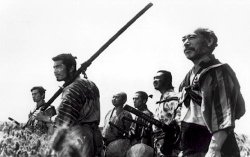The Seven Samurai
The Seven Samurai (七人の侍 Shichinin no samurai, 1954) is a movie by Akira Kurosawa starring Takashi Shimura and Toshiro Mifune. The film takes place in war-ridden 16th century Japan, where a village of farmers looks for ways to ward off a band of marauding robbers. more...
Since they do not know how to fight, they hire seven ronin (lordless samurai) to fight for them. Kurosawa made The Seven Samurai because he wanted to make a real jidaigeki, a period-film that would present the past as meaningful, while also being an entertaining film. Perhaps the most remarkable aspect of the film is Kurosawa's use of the camera. In one scene, the samurai form a vignette, grouped around a campfire. There is long exchange and the characters move about and interact. At the end of the scene they become still and a new vignette is presented. This is all achieved in a single shot, a tribute to the skill of director, actors, cameraman and all the other technicians.
The Seven Samurai is widely regarded as a significant film in many respects. It is regarded by many as one of Akira Kurosawa's greatest achievements. Both on a national and international level, it is regarded as one of the greatest Japanese films ever made, and has been declared the best Japanese movie by many organizations and polls. It is also one of the few Japanese films to become widely known in the West, and is the subject of both popular and critical acclaim; it consistently ranks in the top ten movies on the IMDb Top 250 List and was voted one of the Sight & Sound Directors' Top Ten movies in 2002.
This movie was also an important milestone in movie history. The single largest undertaking by a Japanese filmmaker at the time, it was a technical and creative watershed that became Japan's highest-grossing movie and set a new standard for the industry. Many regard it as the epitome of the action movie, defining such plot elements as the recruiting/gathering of heroes who each display a select talent to form a team, a device since used in many other action movies. Other plot devices such as the reluctant hero, romance between a local girl and youngest hero, and the nervousness of the common citizenry had appeared in other films before this but meshed perfectly in this film. Its use of such cinematographic elements as slow motion and panning battle shots helped to create a movie that would influence cinema worldwide. After the earlier success of Rashomon, this movie solidified Kurosawa as a talent in worldwide film circles. In the decades after its release, The Seven Samurai would inspire many screenwriters and directors, particularly in Hollywood.
Plot
The seven are:
- Kambei Shimada (Takashi Shimura) — the leader
- Katsushiro Okamoto (Isao "Ko" Kimura) — the young samurai who wants to be Kambei's disciple
- Gorobei Katayama (Yoshio Inaba) — a skilled samurai whom Kambei adopts as his right-hand man
- Shichiroji (Daisuke Kato) — an old comrade of Kambei reunited with his friend
- Kyuzo (Seiji Miyaguchi) — a serious, stone-faced samurai who is a supremely skilled swordsman
- Heihachi Hayashida (Minoru Chiaki) — an amiable samurai, lacking in skill, but who retains good cheer in the face of adversity
- Kikuchiyo (Toshiro Mifune) — a clowning would-be samurai who soon proves his worth to the others
The story unfolds gradually, and the heroes are not the cardboard cutouts popular in some action movies. There is a chemistry developing between the villagers and their helpers, and a fairly continuous role reversal. For instance, to attract the samurai into helping them cheaply, the villagers have to act dumb and poor. Later, when the samurai find out what the villagers are really like and think of rebelling against their clients, the clownish samurai Kikuchiyo turns around and shows his real intelligence by convincing his fellow warriors of their need to fight for their clients.
The film's climax is a battle scene, in which the samurai and villagers successfully drive off the attackers. However, four of the hired defenders do not survive the victory, and the remaining three are left to contemplate the village's victory celebration while ruefully noting that the villagers, while grateful for having preserved their land and their families, will not have much use for the warriors now that the fighting is done.
Read more at Wikipedia.org




